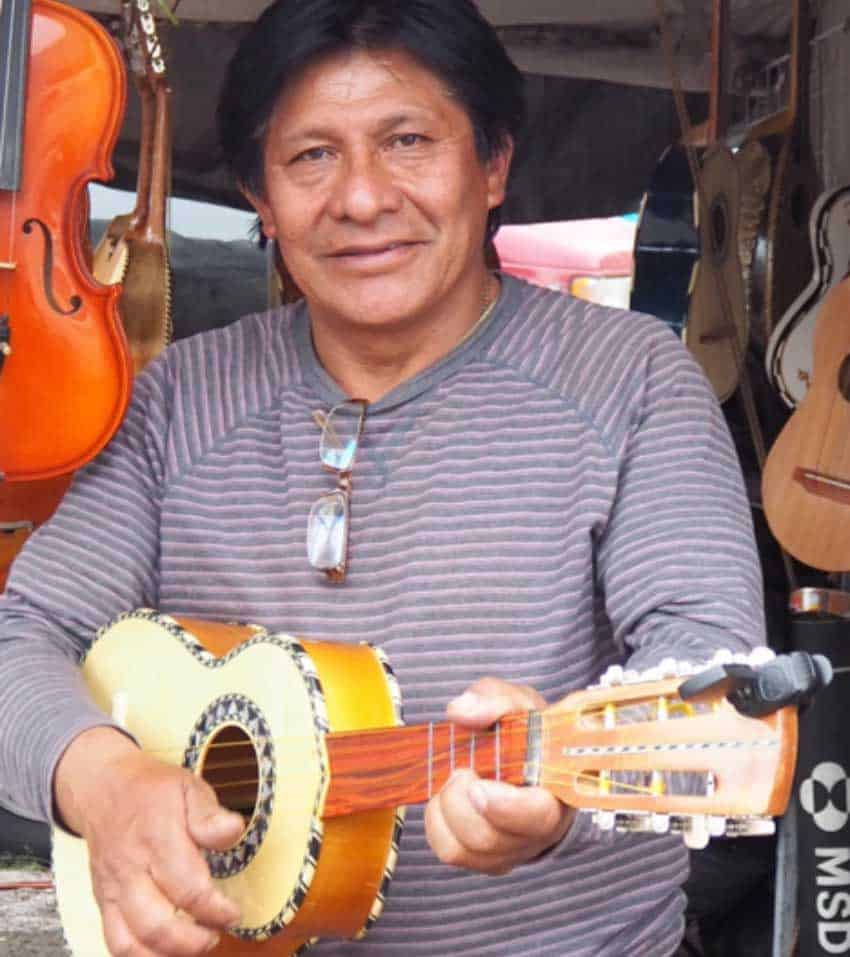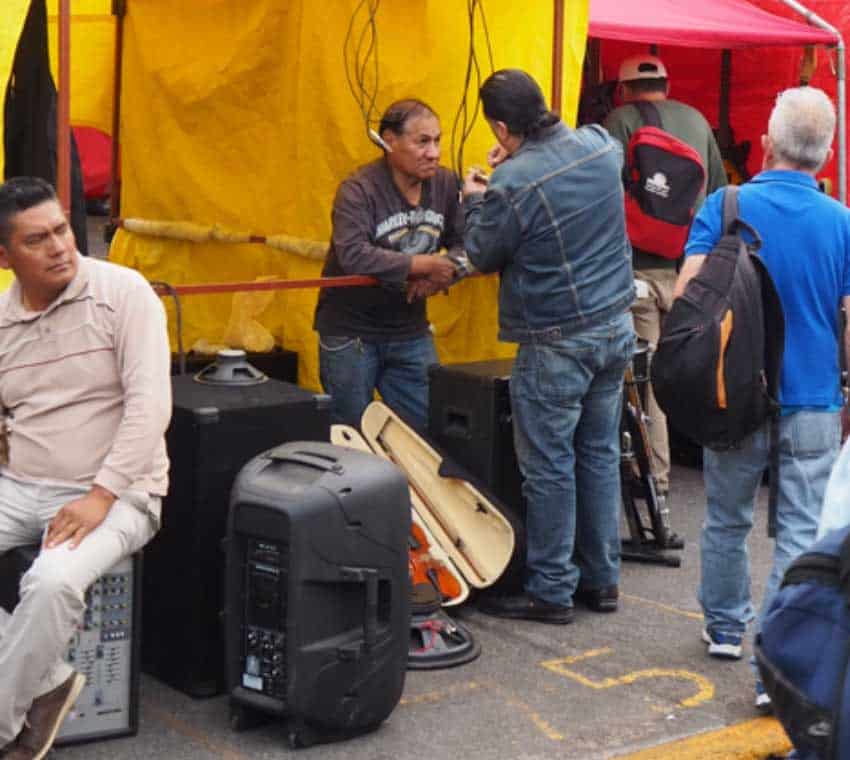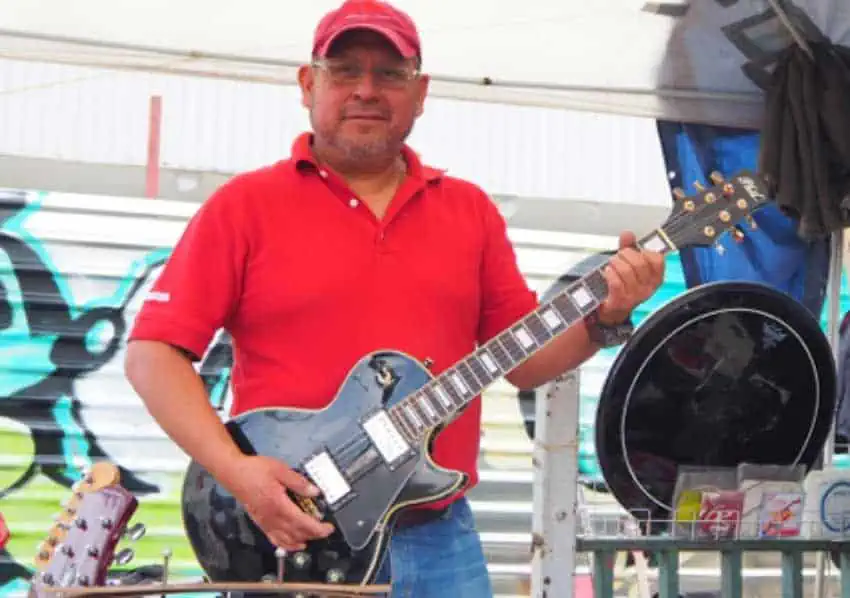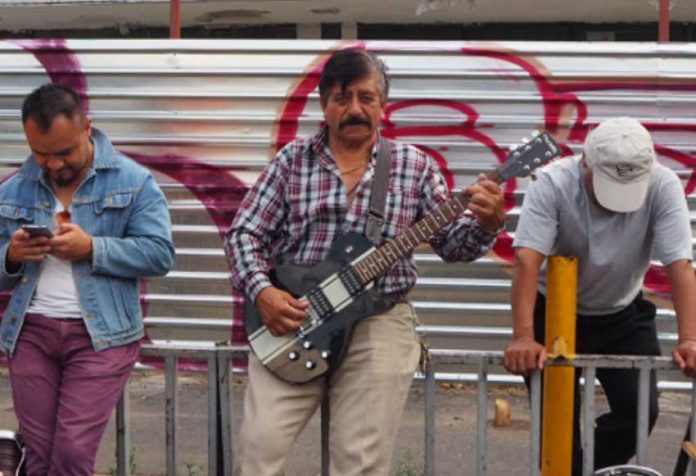The blazing sun reflects off hot blacktop outside the Taxqueña Metro where the disciples of tune and tone arrive, noodling unplugged electric guitars slung over their shoulders, flashily twirling drumsticks while nodding along to imaginary beats or lumbering through with amplifiers against their bellies, rock n’ roll-honed biceps exposed from under black tank tops.
They come every Tuesday for the Bazar Músico Cultural de Taxqueña, Mexico City’s mecca for used instruments and musical paraphernalia, over 100 market stalls running on the street alongside the Mexico City Music Workers Union in Campestre Churubusco, Coyoacán.
Native Mexican instruments, electric and acoustic guitars, keyboards, drums, brass and wind and all manner of knobs, switches and tiny pieces needed to make a musician whole.
Some come for the hard-to-find, some because it’s simply cheaper to trade or buy used, and some come just to pass the time speaking the mother tongue with their fluent brethren.
The sales first sprouted up inside the union doors, but merchandise overcame space and in 1997, the swap meet moved to tiny Calle Cerro del Músico, where the temporary vendor tents now stand in a neat, single row partitioned off from trundling bus traffic by ropes tied to traffic cones, baskets and music stands, with the occasional nut and chapulín vendor helping maintain the barrier.

Jorge Rodríguez has been selling at Bazar Músico Cultural for 25 years, 18 of those out here at his personal stand. He specializes in stringed instruments, with the rarer specimens his favorites, like the small, four-stringed vihuela of 15th-century Iberian heritage and the eight-stringed huapanguera from the Huasteca region of Mexico, both common in Mexican mariachi and folk music.
“It’s better to sell what you like,” he tells me. He’s a seasoned musician, having toured in much of Mexico and into the United States around New York City, and his love for the profession is made clear as he walks me through the origin and history of each his instruments.
Rodríguez’s prices run as low as 600 pesos (US $30) for a ukulele to around 3,000 to 4,000 ($150-$200) for a decent vihuela, with prices going up to as much as 12,000 for something of superior quality in maple or ebony.
Some people walk by with only a single guitar pedal or a handful of drumsticks, hoping to go home with a few pesos or trade up for something better. Long-haired heavy-metalers mix with the straight-laced, classically trained.
Suits from the union pass by glad-handing vendors, and it’s unclear to the uninitiated observer whether the hands meet with genuine esteem or generic disdain. Could be a combination of the two.
Francisco Reyes has been selling at the bazaar for 18 years. He sells everything, he says, though the wares are a little slim today: some drum pieces, a melody harp, a couple of keyboards and drumsticks. Reyes doesn’t want to be in a photo but his friend swats him with a newspaper he’d just borrowed, trying to coax him into the frame, while the camera snaps photos of Reyes’ merchandise. A quick lesson that vendors either refuse to appear in photos or insist on holding guitars for them.

One of the few vendors who isn’t a musician herself, Sandra Sánchez sells brass instruments, mostly trumpets and trombones, generally around 3,500 pesos, she reckons.
She got into the instrument trade through friends and has been selling for about three years, simply because she picked up a knack for selling — and the instruments are certainly beautiful.
I’m told that guitars, keyboards and amplifiers are of principal importance to buyers these days. Most of the vendors are working musicians and many are, or once were, members of the union.
I chat with Guillermo Amaya Espinosa at his stand, an overflowing array of all the tiny hardware, cables, knobs and pieces needed to surgically reassemble dying instruments.
“Right now we do more trading,” Amaya tells me. “We usually sell more, but the economy is a little bit down, so we trade and get a little money.” Amaya gives lessons in guitar, bass, drums and keyboards and volunteers with the Covarrubias Project, a music therapy organization for children with special needs.
His gleeful salesmanship keeps the customers coming, as dozens pass through to peruse his products or display some obscure electronic element in need of replacing. “Something that would cost 20,000 pesos in Centro, you can get from me for 6,000,” he says. “I love music, and I can make a little extra income — and I get the opportunity to hang out at the Bazar.”

When the bargaining heats up, Amaya brings prospective buyers out of the way of general traffic to the back of the tent to get down to the nitty gritty of the transaction. One such negotiation, with Javier Coyotecatl, was over a used banjo head. After about five minutes of back and forth, a deal was made, and both men appeared to leave happy.
Coyotecatl made the long drive up from Cuernavaca. “I repair stringed instruments,” he tells me. “I’m what’s called a luthier.” Coyotecatl has been coming to the market for 25 years or so and only just moved to Cuernavaca about a year ago.
“There’s a good diffusion of culture in Cuernavaca,” he continues. “There’s a lot of work in music. I teach, play, set up events and sell and repair instruments.” But he still comes back to the market because materials are cheaper here, and there are certain things you just can’t get in Cuernavaca.
“Music has given me a lot,” explains Coyotecatl. “I can make trades and sales and it keeps working for me. I studied agronomy, but I liked music better. Then I studied at Bellas Artes. Music is my life. Music gives us everything. It’s like life; it gives us harmony.”
• El Bazar Músico Cultural (or Tianguis del Músico Tasqueña) appears every Tuesday from (approximately) 7:00am to 4:00pm on Cerro del Músico, alongside the Taxqueña Metro stop in Campestre Churubusco.
This is the fourth in a series on the bazaars, flea markets and markets of Mexico City:
